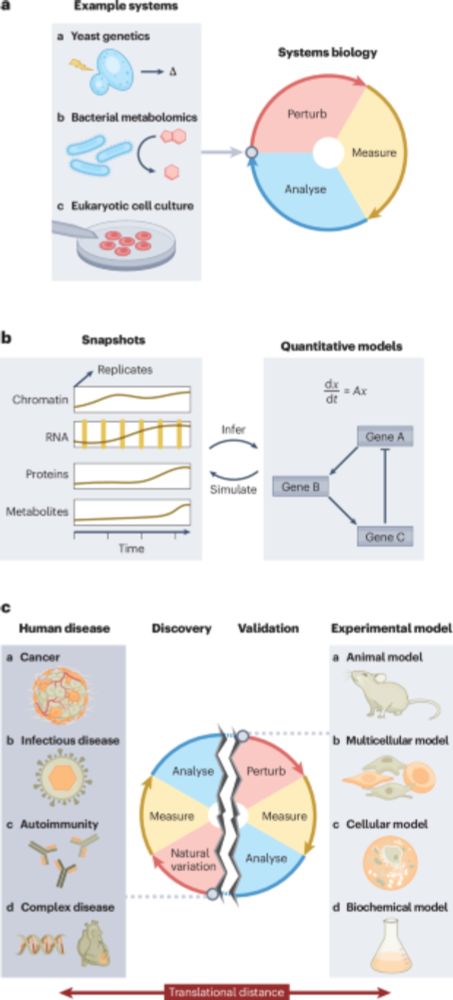
David Fischer
@davidsebfischer.bsky.social
I develop mechanistic machine learning tools for single-cell and spatial omics data to understand the regulatory patterns underlying human disease dynamics.
ai4biomedicine.org
ai4biomedicine.org
Reposted by David Fischer
Our featured article: Adapting systems biology to address the complexity of human disease in the single-cell era go.nature.com/3XBo6Vh #Review by @davidsebfischer.bsky.social, Martin A. Villanueva, Peter S. Winter & @shaleklab.bsky.social @broadinstitute.org @mit.edu @ragoninstitute.bsky.social

Adapting systems biology to address the complexity of human disease in the single-cell era - Nature Reviews Genetics
Differences between humans and experimental models create a translational gap that makes it difficult to extrapolate research findings. The authors review systems-focused approaches to identify and co...
go.nature.com
July 18, 2025 at 8:05 AM
Our featured article: Adapting systems biology to address the complexity of human disease in the single-cell era go.nature.com/3XBo6Vh #Review by @davidsebfischer.bsky.social, Martin A. Villanueva, Peter S. Winter & @shaleklab.bsky.social @broadinstitute.org @mit.edu @ragoninstitute.bsky.social
This review is a product of a great team effort together with Martin Villanueva, Peter Winter and Alex Shalek! www.nature.com/articles/s41... & rdcu.be/ecTna

Adapting systems biology to address the complexity of human disease in the single-cell era - Nature Reviews Genetics
Differences between humans and experimental models create a translational gap that makes it difficult to extrapolate research findings. The authors review systems-focused approaches to identify and co...
www.nature.com
March 13, 2025 at 4:07 AM
This review is a product of a great team effort together with Martin Villanueva, Peter Winter and Alex Shalek! www.nature.com/articles/s41... & rdcu.be/ecTna
In summary, we outline how systems biology is being adapted to the multiscale dynamics of human health and disease in omics-driven as what is effectively a two-loop cycle over discovery and validation.
March 13, 2025 at 4:07 AM
In summary, we outline how systems biology is being adapted to the multiscale dynamics of human health and disease in omics-driven as what is effectively a two-loop cycle over discovery and validation.
We review strategies that can manage this distance and dissect how it relates to understanding cellular systems at specific spatiotemporal scales - be it the cellular scale often considered in the context of single-cell-resolved experiments, or the tissue niche scale captured with spatial omics.
March 13, 2025 at 4:07 AM
We review strategies that can manage this distance and dissect how it relates to understanding cellular systems at specific spatiotemporal scales - be it the cellular scale often considered in the context of single-cell-resolved experiments, or the tissue niche scale captured with spatial omics.
Both are needed to build quantitative models are faithful to human biology and validated through perturbation experiments. However, the usage of two distinct systems incurs a "translational distance" that complicates systems biology approaches that utilize information from the two.
March 13, 2025 at 3:57 AM
Both are needed to build quantitative models are faithful to human biology and validated through perturbation experiments. However, the usage of two distinct systems incurs a "translational distance" that complicates systems biology approaches that utilize information from the two.
In this review, we discuss how one can rationalize what information about a multiscale cellular system is actually captured by on omics study. We leverage that insight to describe how one can translate between discovery efforts in human tissues and validation efforts in experimental model systems.
March 13, 2025 at 3:56 AM
In this review, we discuss how one can rationalize what information about a multiscale cellular system is actually captured by on omics study. We leverage that insight to describe how one can translate between discovery efforts in human tissues and validation efforts in experimental model systems.
However, the dynamics of human tissues in disease settings is multiscale - not only does that impact quantitative models, it also reflects in experimental design and the resources of publicly available data that we have access to. This obstructs attempts at building such quantitative models.
March 13, 2025 at 3:55 AM
However, the dynamics of human tissues in disease settings is multiscale - not only does that impact quantitative models, it also reflects in experimental design and the resources of publicly available data that we have access to. This obstructs attempts at building such quantitative models.
You are already in this one @jasmineplummer.bsky.social!
November 27, 2024 at 4:09 AM
You are already in this one @jasmineplummer.bsky.social!

